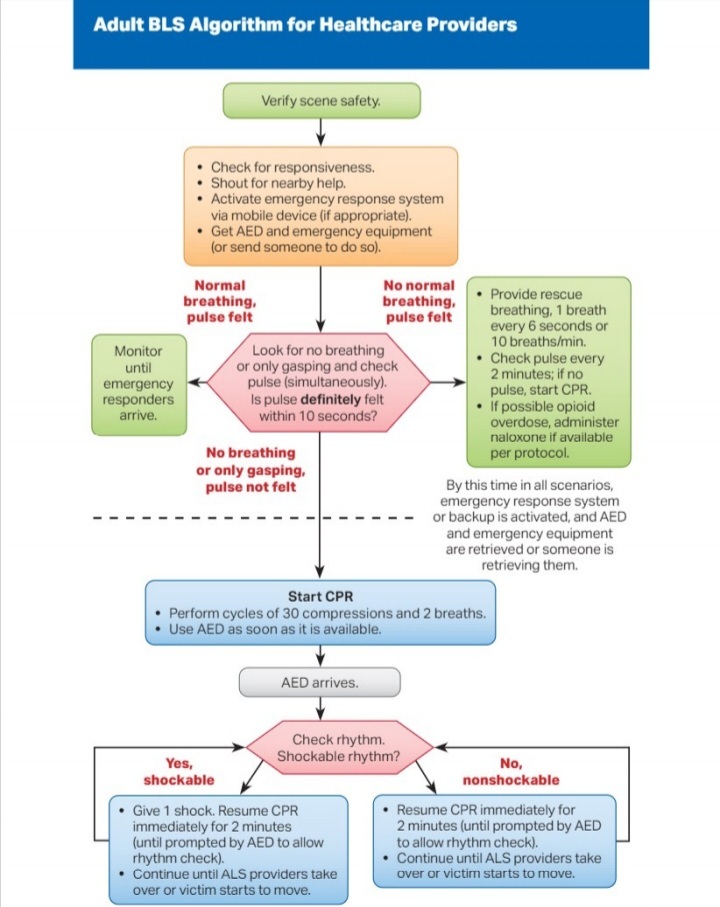(Images can be enlarged if needed)

Cardiac arrest, also known as Sudden Cardiac Arrest, is when the heart stops beating suddenly. The lack of blood flow to the brain and other organs can cause a person to lose consciousness, become disabled or die if not treated immediately.
The terms ‘heart attack’ and ‘cardiac arrest’ are often used interchangeably, but these are two different heart conditions.
A heart attack occurs when there is a blockage in the arteries that stops blood flow in the heart. Due to the lack of blood and oxygen flowing in the heart, the heart muscle tissue will become damaged. Heart attacks can increase the risk for cardiac arrest because heart attacks can alter electrical signals in the heart.
CPR – or Cardiopulmonary Resuscitation – is an emergency lifesaving procedure performed when the heart stops beating. Immediate CPR can double or triple chances of survival after cardiac arrest.
If someone experiences cardiac arrest, they need immediate treatment to increase the flow of oxygen-rich blood to their organs. CPR is the compression over the chest to manually pump a patients heart. Rescue breaths are preformed to provide oxygen to the body.
During CPR, proper hand placement on the lower half of the sternum is crucial. Placing hands over the sternum ensures effective chest compressions directly above the heart, optimizing blood circulation throughout the body.
According to the American Heart Association (AHA), the overall survival rate for out-of-hospital cardiac arrest is around 10%. However, survival rates can be improved if bystander CPR is started immediately. Studies have shown that bystander CPR increases the chances of survival for someone experiencing cardiac arrest. In fact, the AHA reports that survival rates increases to 40% or higher when bystander CPR is performed promptly. The surival rate is between 24% and 40% for those that happen in the hospital, according to the report published online in the Emergency Medicine Journal.
CPR is preformed between 100 - 120 beats per minute. Famously Staying Alive by the Bee Gees is the same beat. A large list of songs with the correct BPM can be found here
![]() The American Red Cross gives the following list of steps to asses if CPR is needed and how to preform:
The American Red Cross gives the following list of steps to asses if CPR is needed and how to preform:
1 CHECK the scene for safety, form an initial impression and use personal protective equipment (PPE)
2 If the person appears unresponsive, CHECK for responsiveness, breathing, life-threatening bleeding or other life-threatening conditions using shout-tap-shout
3 If the person does not respond and is not breathing or only gasping, CALL 9-1-1 and get equipment, or tell someone to do so
4 Kneel beside the person. Place the person on their back on a firm, flat surface
5 The American Red Cross CPR guidelines recommend 100 to 120 chest compressions per minute, 30 at a time. Remember these five points:
Hand position: Two hands centered on the chest
Body position: Shoulders directly over hands; elbows locked
Compression depth: At least 2 inches
Rate of compressions: 100 to 120 per minute
Allow chest to return to normal position after each compression
6
Give 2 breaths
Open the airway to a past-neutral position using the head-tilt/chin-lift technique Pinch the nose shut, take a normal breath, and make complete seal over the person’s mouth with your mouth. Ensure each breath lasts about 1 second and makes the chest rise; allow air to exit before giving the next breath Note: If the 1st breath does not cause the chest to rise, retilt the head and ensure a proper seal before giving the 2nd breath If the 2nd breath does not make the chest rise, an object may be blocking the airway
7 Continue giving sets of 30 chest compressions and 2 breaths. Use an AED as soon as one is available! Minimize interruptions to chest compressions to less than 10 seconds.
Sources:
https://www.hopkinsmedicine.org/health/conditions-and-diseases/cardiac-arrest
https://cpr.heart.org/en/resources/cpr-facts-and-stats
https://www.mycprcertificationonline.com/blog/cpr-success-rate
Instructional images from the AHS Basic Life Support Manual (2020)
Join our public Matrix server! https://matrix.to/#/#tracha:chapo.chat
As a reminder, be sure to properly give content warnings and put sensitive subjects behind proper spoiler tags. It's for the mental health of not just your comrades, but yourself as well.
Here is a screenshot of where to find the spoiler button.



The beautiful legs, we love to see it. I always stop to look when I get out of the shower, lol
Most chairs are really bad under capitalism I hate this so much. Also give me your office chair, based and office theft pilled.
I hate this so much. Also give me your office chair, based and office theft pilled.
Join Estrogen Lifters Club! ✨ But I do find stretching pretty much always helps. Pathetically even stretching is exhausting to me sometimes due to chronic pain but nimble joints are good for you. Might let ya play more...
Based
I have sat in very few good chairs/couches in my life, agree
I wonder if i could sneak out a second one from the office... The shipping costs would probably be enormous tho lol
Yeah I'll give it a shot, thanks! And sad to hear about stretching for you :( I used to do dance for a bit and being super flexible was the best part actually haha
Chairs are bad :/ which I hate to see. Fwiw though the chair I have now is decent, cheap but I can sit for like six hours in it before tiring which is pretty good. It also lacks armrests which I find I like surprisingly, I can sit really weird or slide in and out of it and push it right under my desk.
Stretching I need to do it more and better tbh. Would help.
I need to do it more and better tbh. Would help.
damn, six hours is a really good time as far as I'm concerned. I have to shift around in office chair a lot, not from pain, but just ... huh, I don't really know why...
I Hate Armrests, honestly. I mean, I use them to make sure I'm not bending my wrists awkwardly, but I can't like pull a guitar out at my desk when I'm thinking or whatever
same
Yeah it is, I should be thankful. I do find myself fidgeting and shifting a lot, just out of desire to sit wrong Idk. Autism thing? ADHD thing?
Me too, I'm digging No Armrests gang! I recommend it.
I do it too, I think maybe in order to think? I shift a LOT in my chair, doesn't matter how comfortable, it's a bit noisy and I think it's proabalby noticeable in meetings. I have a position for listening, for active listening, for talking... lol this is weird
I also cannot understand how people can keep both feet on the floor ever. I am the meme about ND sitting lol
I should see if I can remove these ones
Oh no that's cool actually, positions for different social things and whatever. That's kinda neat, I think I just fidget or do it to stretch my legs or things like that.
Honestly both feet on the floor hurts me. ND sitting is based. REMOVE those armrests!!!
that's my best theory haha, i do just shift around every few minutes
i see some bolts there, but i'm not sure if they are uh load bearing and they don't seem clearly connected to the armrests ... hmm, i'm a little afraid to experiment lol, maybe i can find a manual online
I couldn't find the original one, but this one is kind of similar lol (also, ripping something up, oops i feel called out, I'm surprised no one has ever commented on this, I do it everywhere, even in public...)